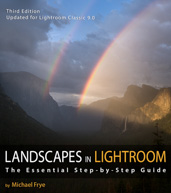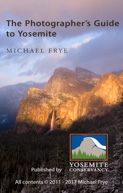by Michael Frye | Oct 6, 2010 | Yosemite Photo Conditions
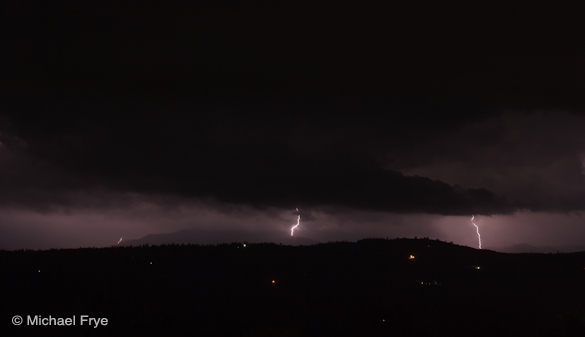
Lightning striking the Sierra foothills near Mariposa on Sunday night
October literally started with a bang, as thunderclaps rang through Yosemite Valley. It poured Saturday afternoon. Near Pohono Bridge the Merced River was brown, filled with silt, something I’ve seen only a few times in the last 27 years.
At about 11 o’clock Sunday night my wife and I got in our outdoor hot tub—a nightly ritual—and immediately noticed flashes behind the ridge to our west. We couldn’t hear anything, but knew it must be distant lightning. The frequency was impressive, a nearly constant flickering.
Even though we planned to head over Tioga Pass to Bishop the next morning, and needed to get up early, we decided to go out and take a look. We drove to a spot on Triangle Road, less than half a mile from our house in Mariposa, with a panoramic view to the south. From there we could see that flickering behind a ridge to the west, but also an even more intense thunderstorm to the south, near Fresno. This second cell put on a great light show, with nearly continuous flashes. It gradually moved closer, then slid by to the east, so we were able to watch it for over two hours.
Of course I tried to photograph the lightning, but unfortunately we saw few bolts hit the ground. Most of the show consisted of cloud-to-cloud lightning, and the streaks were usually hidden within the clouds. But I managed to capture a few good images, including the one at the top of this post.
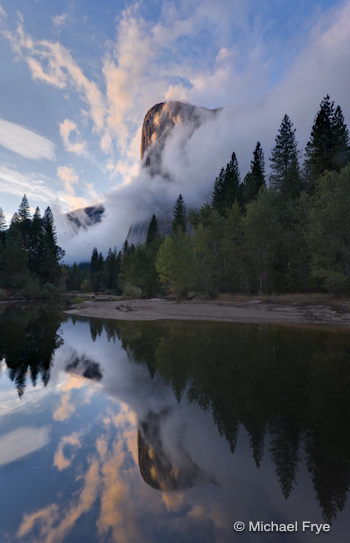
El Capitan at sunset, Tuesday evening
By the next morning rain had changed to snow at the higher elevations of the Sierra, and Tioga Pass was closed. We started driving north to Sonora Pass, but then learned that had closed too. Reluctantly we turned around rather than face a six or seven hour drive to Bishop.
I had to console myself by photographing a beautiful, seldom-visited location: Yosemite Valley. After receiving almost two inches of rain since Friday, skies cleared over the valley Tuesday, and I was able to photograph El Capitan at sunset surrounded by mist and clouds.
Since I never made it to the other side of the mountains, I can’t tell you first hand about the fall color over there, but Evan Russell, an Ansel Adams Gallery staff photographer and one of my workshop assistants, told me that the color is great west of Bishop around North Lake, South Lake, and Lake Sabrina. Or at least it was Monday. Tuesday it snowed up there, and many aspens lost their leaves. Typically a storm will strip most of the trees that are already turning, so it may be another week or two until the trees that are now green will change and provide another dose of fall color.
News like this—that some of the early season aspen spots may lose their leaves—often elicits anxious comments in forums, with people worried that they may have missed fall, and others adding fuel to the angst by saying that if you don’t go right now, or better still, yesterday, you’ll miss the most fantastic, wondrous, amazing fall color ever!
Let me assure you that fall isn’t over in the Sierra. Most of the aspens in classic eastern Sierra spots like McGee Creek, June Lake Loop, Lee Vining Canyon, and Lundy Canyon are still green, and probably weren’t adversely affected by the recent storms. While there are no guarantees—there are many little-understood factors that affect fall foliage—chances are good that these areas will produce wonderful color later in the month. I’ve made many of my best aspen photographs during the third week of October. Here’s one example.
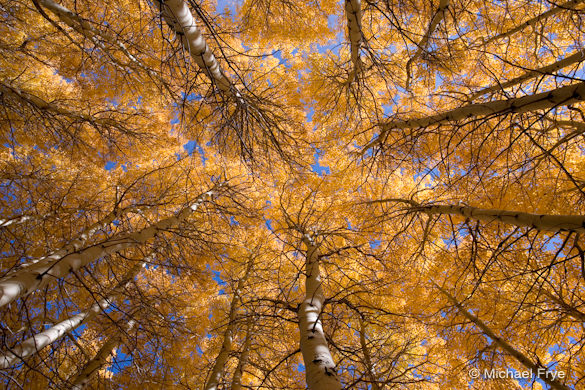
Aspen Grove, June Lake Loop, October 23rd, 2006
And if the aspens don’t produce more great color this year, there are always maples, dogwoods, oaks, and cottonwoods in Yosemite Valley. Peak fall foliage in the valley doesn’t usually occur until the end of October or beginning of November, but the rain and cold temperatures have set things in motion, and many maples and dogwoods have already started to change color. It looks like autumn might arrive early in the valley this year, but these things are always hard to predict.
I’m hoping to try again to get over to the east side later this week, so I’ll let you know what I find. In the mean time, a good resource for fall color reports is the Calphoto web site. Also, if you’ve been photographing aspens recently, or captured some of the storm activity in Yosemite, please use the comments to tell us what you found, and post links to photos!
by Michael Frye | Jul 13, 2010 | Announcements, Workshops
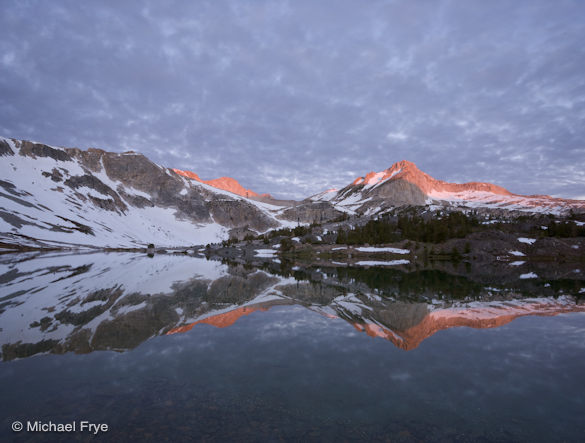
North Peak and Greenstone Lake, sunrise
I just finished teaching the Hidden Yosemite workshop for The Ansel Adams Gallery. Every year this is a really fun class, and this time was no exception. There’s something about being away from the roads that adds an extra dimension to the workshop. We had a great group, and the weather was excellent. Saturday morning at Greenstone Lake was probably the photographic highlight, with glassy water and a great mix of sun and clouds—the first time I’ve seen clouds at sunrise from this spot. The photograph above shows the first blush of light on North Peak; later, in the image below, I used a four-stop neutral-density filter, plus a polarizer, to slow the shutter speed and blur the fast-moving clouds.
We had a slide show on the last day of the workshop, and everyone in the class showed great images from Saturday morning—how could you miss with light like that? But we also saw many interesting, imaginative photographs from all the other locations we visited. It was great to see everyone’s growth over the five days of the workshop. I’ll post a link to some of the student’s photos at some point.
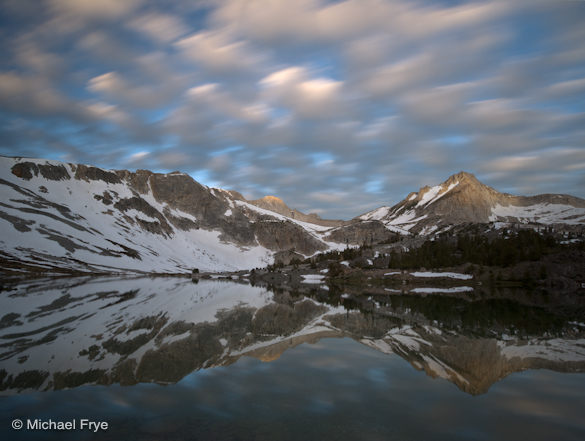
Fast-moving clouds above Greenstone Lake
by Michael Frye | Jul 5, 2010 | Yosemite Photo Conditions
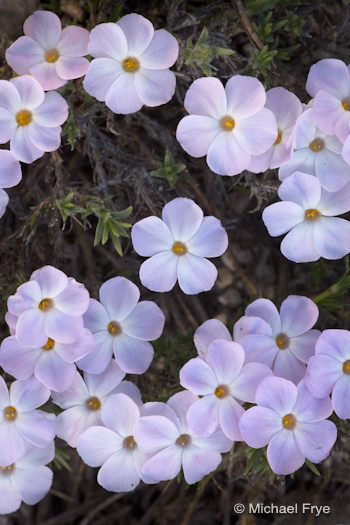 Claudia and I spent Fourth of July weekend in the Yosemite High Country, scouting for my upcomingHidden Yosemite workshop. There’s still plenty of water flowing in the creeks and rivers, and some big reflecting ponds remain in the west end of the main Tuolumne Meadow. Some flowers have appeared, like the spreading phlox shown here, penstemon along the side of the Tioga Pass Road between Yosemite Creek and Olmsted Point, and a few patches of shooting stars in damp meadows. I’m sure more flowers will be blooming soon. It promises to be a good wildflower year in the high country, but the peak probably won’t arrive until at least early August.
Claudia and I spent Fourth of July weekend in the Yosemite High Country, scouting for my upcomingHidden Yosemite workshop. There’s still plenty of water flowing in the creeks and rivers, and some big reflecting ponds remain in the west end of the main Tuolumne Meadow. Some flowers have appeared, like the spreading phlox shown here, penstemon along the side of the Tioga Pass Road between Yosemite Creek and Olmsted Point, and a few patches of shooting stars in damp meadows. I’m sure more flowers will be blooming soon. It promises to be a good wildflower year in the high country, but the peak probably won’t arrive until at least early August.
My nickname for shooting stars is “mosquito flowers,” because they grow in boggy areas and always seem to blossom at the same time as the mosquitos. Just the sight of shooting stars makes me itchy. And sure enough, the mosquitos were out, but we didn’t encounter any maddening, intolerable swarms. I’m keeping my fingers crossed, hoping that these little pests won’t be too bad this year, but it’s probably just a little too early for them at the higher elevations. But even clouds of mosquitos won’t keep me away—the high country is just too beautiful to miss.
by Michael Frye | Jun 21, 2010 | Yosemite Photo Conditions
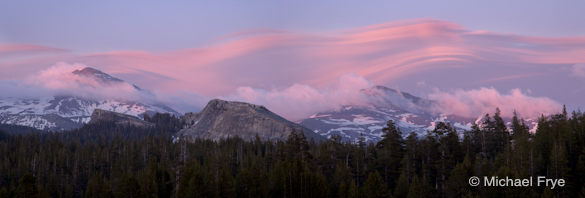
Lenticular cloud above Mounts Dana and Gibbs
Saturday Claudia and I drove up to Tuolumne Meadows. There was still lots of snow in the high country—not as much as when the pass first opened, of course, but plenty. We hiked around Pothole Dome to the place where the Tuolumne River starts to tumble down from the west end of the meadows, as I wanted to photograph these cascades with high water. We had the place to ourselves and it was beautiful. Claudia took a short video of that upper cascade, which I posted on Facebook.
We kept our eyes on a big lenticular cloud that had formed over the mountains to the north, but it seemed to dissipate near the end of the day. As we walked back up to the main meadow near sunset, however, we saw that a smaller lenticular cloud was riding above Mt. Gibbs, so we rushed to a spot closer to the road and caught the last sunset light on the mountains. I assembled the panorama above from two images zoomed in on the peaks.
We didn’t get home until 11 p.m., but it was worth it. We had a great afternoon in a special place.
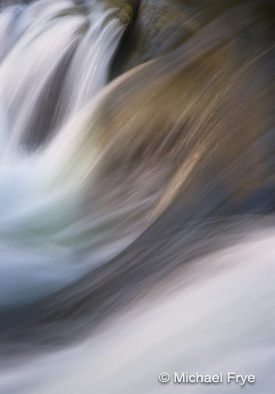
Water leaving Tuolumne Meadows (this is the cascade in the video)
by Michael Frye | Jun 12, 2010 | Yosemite Photo Conditions
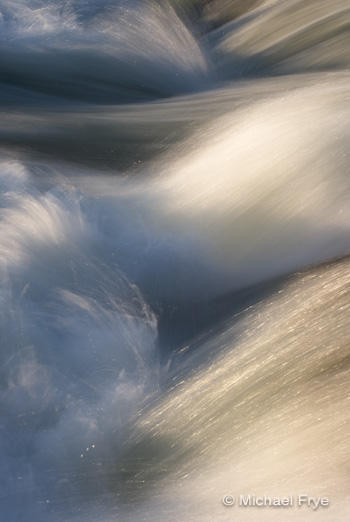 While the snow at high elevations in Yosemite is melting rapidly, there’s still plenty around,enough to keep the water flow high as it melts. While the snow at high elevations in forecast calls for warmer temperatures Sunday and Monday, so the water volume in Yosemite Valley should increase—maybe not to the level we saw last weekend, but close. After that, temperatures are supposed to cool down again, so that may be the end of the highest water this year, as most of the snow will be gone soon.
While the snow at high elevations in Yosemite is melting rapidly, there’s still plenty around,enough to keep the water flow high as it melts. While the snow at high elevations in forecast calls for warmer temperatures Sunday and Monday, so the water volume in Yosemite Valley should increase—maybe not to the level we saw last weekend, but close. After that, temperatures are supposed to cool down again, so that may be the end of the highest water this year, as most of the snow will be gone soon.
















